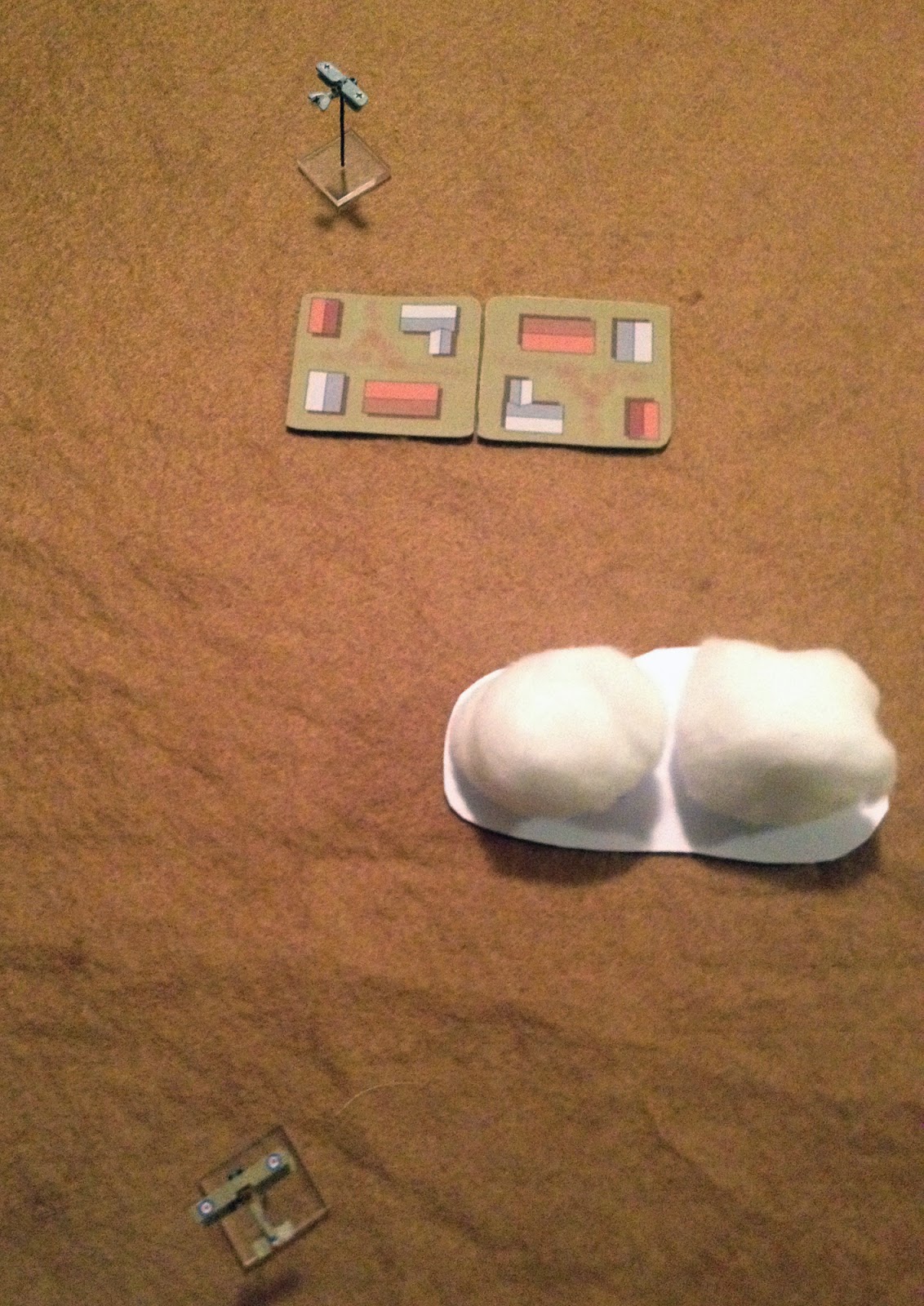How could I manage to take so many pictures of three games so devoid of real incident? Ah, the perils of unrestrained digital photography.
I am continuing to fiddle about with ideas for Spandau and Lewis, and in-between getting home from work and having tea I played three quick games to try out a scenario that came to me in an idle moment at work.
I wanted to try a very, very early war game, where both sides had unarmed planes but were touting rifles. I'd worked out some simple rules for using small-arms, and thought that it would be fun to try them. I also wanted to try a tiny tweak to the maneuver rules as well.
So, it's early 1915. A German Rumpler C1 sets off on a reconaissance flight, its target being that village in the distance. The observer has a rifle, which enables him to shoot into any arc but the front one.
Lurking in the same sector is a Bristol Scout. This is also unarmed, but the pilot also has a rifle. He can fire it left and right only, but if he maneuvers he gets a penalty (flying a plane and aiming a rifle being incompatible). However I made him a marksman, which meant that if he did score a hit it would be more likely to be telling.
I used the spotting rules. The German plodded slowly up the table, whilst the Scout tried to get a clear view. But the (randomly placed) cloud kept getting in the way.
The Germans spotted the Scout, and quickly pressed on with their mission, overflying the village and getting the photo they needed. All they had to do was get it home.
The Germans turn for home, whilst the Scout patrols, oblivious to their presence.
Back to the German lines goes the Rumpler. It has a store of power and applied it to add speed, diving for home in a dramatic manner.All pointless, as the Scout still hasn't spotted it.
And so to safety ...
The Scout continues to circle, unaware that a game has even taken place.
The next day the Germans send the Rumpler out to photograph another village. The same Scout is patrolling.
The planes spot each other this time.
The Germans take a pot-shot at the Scout ...
... who returns the favour whilst the Germans photograph the village. Both planes are rolling between two and three dice, needing sixes for a potential hit. Neither side rolled any.
With their photo safely take the Germans turn for home, using the greater power of their plane to evade the more nimble British plane.
Another successful mission, with only a couple of shots exchanged.
The Rumpler needed maintenance after that last mission, because the Germans sent a more agile, but slower and far less powerful DFW C1 out the next day (in reality I realised that the Rumpler B1 really outclassed the Scout in this set-up).
The Scout comes in again. As an aside you'll notice that the Bristol Scout is played by one of my home-made BE2s, whilst the Rumpler and the DFW are actually a Roland CII.
The Scout really has the jump on the Germans this time, and opens fire before they realise he's there. Despite his advantage he misses (I allow planes shooting at an unalerted target an extra dice when firing).
As the Germans head towards the village, both planes exchange long-range fire.
The Germans overfly the village, but the observer fails to get a clear view. They will need to go around again.
They fly into a cloud, as a temporary refuge from the advancing Scout.
Their turn takes them off the board. But who's checking? The scout closes in, and more shots are exchanged to no effect.
The Germans start another photo run, whilst the Scout plugs away at long range.
The Germans get their photo, but without the power of the Rumpler they will have a tough run home as the Scout is more agile and flies faster.
The planes close up and there is plenty of ineffective rifle fire ...
... until finally the Germans score a potential hit. It comes to nothing.
The Germans sideslip, forcing the Scout to maneuver, which throws off his aim.
Bang! The Germans score another hit, and the Scout has to break off with a disabled engine.
Another victory for the Kaiser! And Photoshop Elements.
Rules: I treated the small arms as normal fire in terms of determining dice, but only sixes counted as potential hits. No damage was scored, but the normal check for criticals was made. A score of 3 or 4, however, only caused one point of damage, instead of four (so it was virtually impossible to bring a plane down by shooting it to bits). The maneuver tweak was to allow a +1 on the Maneuver Table for planes that were more than 6" from any enemy when it came to checking their move. This should get planes back into the fight more easily.
I am still working out how to balance the rate at which damage is dished out. I have considered radically dropping the ammo supply (to restrict shots) reducing the chances of a hit or increasing the number of hits a plane can take. The latter strikes me as the most interesting; having fewer shots, or missing a lot, is more frustrating to a player than progressively whittling down their foe. I may still drop ammo to 8, though, whilst increasing the number of hits a plane can take by about 20%. Since the criticals offer a Sudden Death option, it should be possible to down one or more opponents, if you're fortunate. Obviously I didn't really try out these changes in this game, as the damage was irrelevant.




























Nice report and great looking game!
ReplyDelete